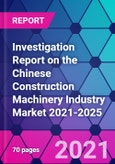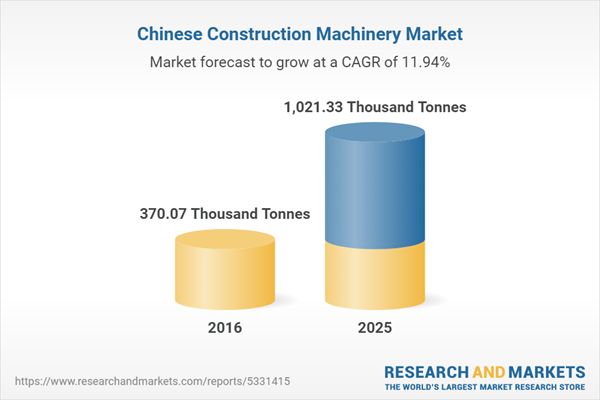The production and export volume of China’s construction machinery industry has been ranked first in the world. By the first half of 2021, 11 Chinese companies have been listed among the top 50 construction machinery companies in the world. Also, China’s sales and growth rate of sales have risen to first place in the world.
According to this market research, the development cycle of the construction machinery industry is basically consistent with the macroeconomic development trend. The prosperity of China’s construction machinery is affected by many factors such as the domestic market demand, exports and government policies, which in general are supportive.
The demand in the Chinese construction and machinery market is oriented by investments in fixed assets like real estate and infrastructure. In general, when China’s real estate and infrastructure investment increases, the demand for construction machinery will follow the step. Fixed asset investment demand is the main factor affecting the development of the domestic construction machinery industry. By 2020, infrastructure accounted for the largest proportion of construction machinery demand (about 45%), and mining and real estate took up about 20% respectively.
The market research shows that China’s whole set of construction machinery products are mainly exported to countries and regions including the United States, Russia, Japan, Australia, India, and Vietnam, while the machinery parts are mainly exported to the United States Europe and European countries. In 2017, the export value reached USD 20.969 billion, with a reduction of 13.6% YOY. The main reason for this reduction is the target market was greatly affected by the outbreak of COVID-19. In 2020, China’s construction machinery exports to major export target countries fell by about 8.6% YOY. Exports to countries along the “Belt and Road” were US$8.973 billion, accounting for 42.8% of total exports. The decline rate of exports is 16.8%, which was higher than the decline of total exports. Exports to the BRICS countries amounted to US$2.511 billion, accounting for 12%, with a year-on-year decrease of 9.29%. Among them, the Brazilian market share showed a rare increase, with a growth rate of 0.1%.
According to the analysis, with the improving strength of China’s construction machinery manufacturing, many Chinese companies have entered the international market through mergers and acquisitions, which enables them to make use of the brand, technology and sales channels of the acquired targets so as to make inroads into the global arena
By 2020, the urbanization level in China was about 63.9%, which was above the middle level in the world, far lagging behind that of developed countries. During 2018-2022, the urbanization rate is expected to reach 65.5%, namely, an increment of more than 80 million urban population. The rise of urbanization will promote the development of real estate and infrastructure construction, and further drive the demand for construction machines. In addition, the Report on Digital Development in Rural China 2020 pointed out that rural areas in China will continue to develop during the 14th Five-Year Plan period (2021-2025). Therefore, the modernization of rural infrastructure and other modernization will promote the demand for construction machinery in China. At the same time, with the alleviation of the new crown epidemic, overseas sales of Chinese construction machinery will have a recovery growth, and export value may see great growth. Overall, from 2021 to 2025, the construction machinery industry in China will continue to develop.
Key Topics:
- Government policies of China’s construction machinery industry
- Supply and demand of China’s construction machinery industry
- Analysis of the import and export of China’s construction machinery industry
- Major construction machinery manufacturers in the Chinese market
- Competition landscape of China’s construction machinery
- The driving forces and market opportunities of China’s construction machinery industry, 2021-2025
- Threats and challenges by China’s construction machinery industry, 2021-2025
- Prospects for China’s construction machinery industry, 2021-2025
Table of Contents
1 Basic Concepts of Construction Machinery Industry
1.1 Definition and Classification of Construction Machinery Industry
1.1.1 Definition
1.1.2 Analysis of Industry Chain
1.1.3 Analysis of the Relationship between Various Subsectors of Construction Machinery Industry
1.1.4 Main Products of Construction Machinery Industry
1.2 Economy Status of Construction Machinery Industry in China
1.3 The Impact of COVID-19 on Construction Machinery Industry in China
2 Development Environment of Construction Machinery Industry in China, 2016-2020
2.1 Economic environment
2.1.1 Global Economy
2.1.2 China’s Economy
2.2 Policy Environment of Construction Machinery Industry
2.2.1 Policy Overview
2.2.2 Policy Trend
3 Operation Status of Construction Machinery Industry in China, 2016-2020
3.1 Supply Status of Construction Machines in China
3.1.1 Overview of Production Volume of Construction Machines
3.1.2 Bulldozer
3.1.3 Loader
3.1.4 Excavator
3.1.5 Forklift
3.1.6 Road roller
3.1.7 Crane
3.1.8 Concrete Machinery
3.2 Demand Status of Construction Machines
3.2.1 Market size
3.2.2 Main Demand Markets of Construction Machines
3.4 Analysis of Investment and Financing of Construction Machinery Industry in China
3.4.1 Investment in Fixed Assets
3.4.2 Mergers and Acquisition (M&A)
4 Competition Status of Construction Machinery Industry in China Industry
4.1 Barriers to Entry
4.1.1 Technological and Capital Barriers
4.1.2 Policy Barriers
4.2 Competition Structure
4.2.1 Bargaining Power of Upstream Suppliers
4.2.2 Bargaining Power of Downstream Customers
4.2.3 Competition Status
4.2.4 Potential Competitors
4.2.5 Substitutes
5 Analysis of Industrial Chain of Construction Machinery in China, 2016-2020
5.1 Upstream Construction Machinery Industries
5.1.1 Iron & Steel Industry
5.1.2 Non-ferrous Metal Industry
5.1.3 The impact of Upstream Industries on Construction Machinery Industry
5.2 Downstream Industries
5.2.1 Real Estate
5.2.2 Railway Construction
5.2.3 Highway Construction
5.2.4 Water Conservancy Engineering
5.2.5 Electric Power Industry
5.2.6 Coal Industry
6 Analysis of Subsectors of Construction Machinery Industry in China, 2016-2020
6.1 Excavator
6.1.1 Supply and Demand
6.1.2 Competition of Excavator Industry
6.2 Loader
6.2.1 Supply and Demand
6.2.2 Competition of Loader Industry
6.3 Forklift Truck
6.4 Compaction Machinery
6.5 Crane Industry
6.6 Concrete Machinery Industry
6.7 Bulldozer Industry
7 Import and Export of Construction Machinery Industry in China, 2016-2020
7.1 Imports of Construction Machinery in China
7.1.1 Import Overview
7.1.2 Structure of Imported Products
7.1.3 Main Import Sources
7.2 Exports of Construction Machinery
7.2.1 Export Overview
7.2.2 Structure of Exported Products
7.2.3 Main Export Destinations
8 Major Manufacturers of Construction Machinery in the Chinese market, 2016-2020
8.1 XCMG Construction Machinery Co., Ltd.
8.1.1 Enterprise Profile
8.1.2 Operation Statu
8.2 Sany Heavy Industry Co., Ltd.
8.2.1 Enterprise Profile
8.2.2 Operation Status
8.3 Zoomlion Heavy Industry Science & Technology Co., Ltd.
8.4 Guangxi Liugong Machinery Co., Ltd.
8.5 China Railway Construction Heavy Industry Co., Ltd.
8.6 Shantui Construction Machinery Co., Ltd.
8.7 Lovol Heavy Industry CO., LTD
8.8 Xiamen XGMA Machinery Co., Ltd.
8.9 Northern Construction Equipment Co., Ltd.
8.10 Lonking Machinery Co., Ltd
8.11 Sunward Intelligence Equipment Co., Ltd.
8.12 China National Machinery Industry Corporation
8.13 Qingdao Tianneng Heavy Industry Co., Ltd.
8.14 Qingdao Choho Industry Co., Ltd.
8.15 Luoyang Xinqianglian Slew Bearing Co., Ltd.
8.16 Shaanxi Construction Machinery Co., Ltd.
8.17 Hongsheng Technology Co., Ltd.
8.18 Hangcha Group Co., Ltd.
8.19 Shenzhen Liande Automatic Equipment Co., Ltd.
8.20 Zhongding Anhui Sealing Parts Co., Ltd.
9 Forecast of Development of Construction Machinery Industry in China, 2021-2025
9.1 Influencing Factors for Development of Construction Machinery Industry in China, 2021-2025
9.1.1 Driving Forces and Market Opportunities of Construction Machinery Industry, 2021-2025
9.1.2 Threats and challenges of Construction Machinery Industry, 2021-2025
9.2 Forecast on Supply of Construction Machinery Industry in China, 2021-2025
9.3 Forecast on Demand of Construction Machinery Industry in China, 2021-2025
List of Charts
Chart Industry Chain of Construction Machinery Industry in China
Chart Product Classification of Construction Machinery Industry in China
Chart key Policies on Construction Machinery Industry in China, 2016-2020
Chart Production Volume of Major Products in Construction Machinery Industry in China, 2016-2020
Chart Market Size of Construction Machinery Industry in China, 2016-2020
Chart Overseas M&As of Chinese Construction and Machinery Enterprises
Chart Production Volume of Major Products in Iron and Steel Industry in China, 2016-2020
Chart Coverage of Newly-built Houses in China, 2016-2020
Chart Miles of Newly-built Railways in China, 2016-2020
Chart Production Volume of Coal in China, 2016-2020
Chart Production Volume of Excavators in China, 2016-2020
Chart Production Volume of Loaders in China, 2016-2020
Chart Production Volume of Forklifts in China, 2016-2020
Chart Sales Volume of Forklifts in China, 2016-2020
Chart Production Volume of Concrete Machines in China, 2016-2020
Chart Import Value of Construction Machinery to China, 2016-2020
Chart Import Sources of Construction Machinery to China in 2020
Chart China’s Export Value of Construction Machinery, 2016-2020
Chart Export Destinations of China’s Construction Machinery in 2020
Chart Profile of XCMG Construction Machinery Co., Ltd.
Chart Operation Status of XCMG Construction Machinery Co., Ltd.
Chart Profile of SANY Group Co., Ltd.
Chart Operation Status of SANY Group Co., Ltd.
Chart Forecast on Market Size of Construction Machinery Industry in China, 2021-2025
Chart Forecast on Import and Export Value of Construction Machinery in China, 2021-2025
Samples

LOADING...
Companies Mentioned
- China National Machinery Industry Corporation
- China Railway Construction Heavy Industry Co., Ltd.
- Guangxi Liugong Machinery Co., Ltd.
- Hangcha Group Co., Ltd.
- Hongsheng Technology Co., Ltd.
- Lonking Machinery Co., Ltd
- Lovol Heavy Industry CO., LTD
- Luoyang Xinqianglian Slew Bearing Co., Ltd.
- Northern Construction Equipment Co., Ltd.
- Qingdao Choho Industry Co., Ltd.
- Qingdao Tianneng Heavy Industry Co., Ltd.
- Sany Heavy Industry Co., Ltd.
- Shaanxi Construction Machinery Co., Ltd.
- Shantui Construction Machinery Co., Ltd.
- Shenzhen Liande Automatic Equipment Co., Ltd.
- Sunward Intelligence Equipment Co., Ltd.
- XCMG Construction Machinery Co., Ltd.
- Xiamen XGMA Machinery Co., Ltd.
- Zhongding Anhui Sealing Parts Co., Ltd.
- Zoomlion Heavy Industry Science & Technology Co., Ltd.
Methodology
Background research defines the range of products and industries, which proposes the key points of the research. Proper classification will help clients understand the industry and products in the report.
Secondhand material research is a necessary way to push the project into fast progress. The analyst always chooses the data source carefully. Most secondhand data they quote is sourced from an authority in a specific industry or public data source from governments, industrial associations, etc. For some new or niche fields, they also "double-check" data sources and logics before they show them to clients.
Primary research is the key to solve questions, which largely influence the research outputs. The analyst may use methods like mathematics, logical reasoning, scenario thinking, to confirm key data and make the data credible.
The data model is an important analysis method. Calculating through data models with different factors weights can guarantee the outputs objective.
The analyst optimizes the following methods and steps in executing research projects and also forms many special information gathering and processing methods.
1. Analyze the life cycle of the industry to understand the development phase and space.
2. Grasp the key indexes evaluating the market to position clients in the market and formulate development plans
3. Economic, political, social and cultural factors
4. Competitors like a mirror that reflects the overall market and also market differences.
5. Inside and outside the industry, upstream and downstream of the industry chain, show inner competitions
6. Proper estimation of the future is good guidance for strategic planning.

LOADING...
Table Information
| Report Attribute | Details |
|---|---|
| No. of Pages | 70 |
| Published | May 2021 |
| Forecast Period | 2016 - 2025 |
| Estimated Market Value in 2016 | 370.07 Thousand Tonnes |
| Forecasted Market Value by 2025 | 1021.33 Thousand Tonnes |
| Compound Annual Growth Rate | 11.9% |
| Regions Covered | China |
| No. of Companies Mentioned | 20 |









